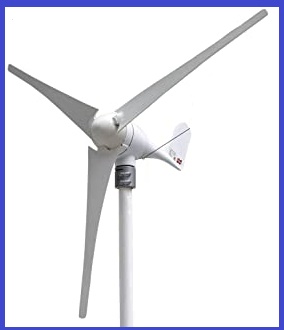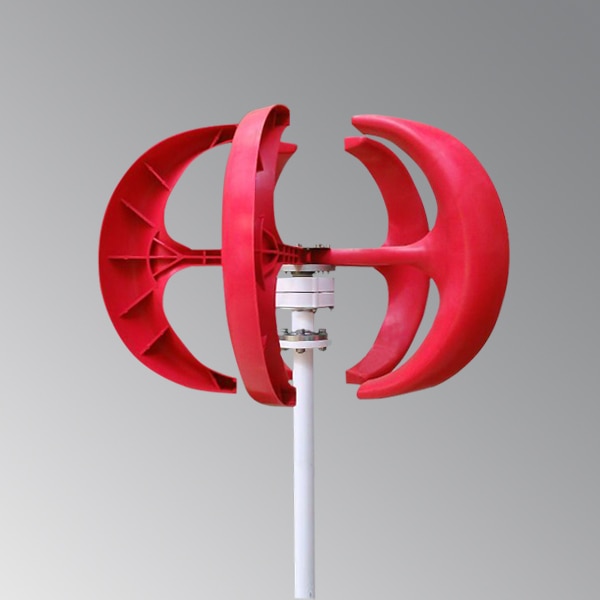Wind Turbines
Low-profile is needed here. A thirty-foot tower mounted in a sixty-four square foor concrete pad might produce a greate deal of power, but it is an eyesore and occupies valuable crop space.
I have in mind a vertical spindle turbine, no higher than eighteen inches, mounted on the ridge of my house and or shed.

I do not want a "weather-vane" propellor like the one shown above.

I have in mind something like this.
I reason that a weather-vane turbine must be using some small part of the wind energy to re-adjust its direc tion every second or so. Over 3,600 seconds that adds up (or rather, subtracts!).
A rotating spindle operates regardless of the wind direction and, in theory, all the wind energy is used to turn the blades.
Of course the intrinsic efficiency of the turbine counts for something.
Description
The nomenclature is new to me, so first I need to know what the descriptive terms mean, and then I can filter search results by the terms that are relevant to my situation.
Price: |
$1,099.90 + $129.00 shipping |
|---|---|
Brand |
MAKEMU Energy |
Wattage |
1000 Watts |
Item Dimensions LxWxH |
25.59 x 51.18 x 45.28 inches |
Item Weight |
15.43 Pounds |
Color |
Neutral |
Voltage |
12.24 Volts |
Engine Type |
Brushless |
A) BASIC configuration: |
M28 (rotor 3 blades) + M12 (alternator).NO pole! |
B) PLUS configuration: |
DOMUS BASIC + M36 (rectifier) + M40 (pole 85 cm) |
C) STAND ALONE configuration: |
DOMUS PLUS + M26 (controller) + (your battery / not included) + M22 (STAND ALONE inverter) |
D) GRID CONNECTED configuration: |
DOMUS PLUS + M26 (controller) + (your battery / not included) + M34 (GRID inverter) |
Price
Well of course price is important, and "you gets what you pays for" and so on. My aim is to implement power generation and storage in a modular fashion, and to promote a kit that has a low price for beginners, or those who are curious about wind power.
$1,000 is way above my range. I think that a price for me would be $100, and that is Canadian dollars, including tax, shipping and so on.
I can see me telling someone "Well I paid just under a hundred dollars Canadian, tax, shipping included", but I would feel bad if I were trying to persuade someone to experiment with "Just over four hundred dollars Canadian, tax, shipping included".
My Price criteria will be "$100 all up"
If I can demonstrate some real figures from my backyard to show a good ROI, then I can improve the standard module – for me. But first I have to be convinced that this will work in Bonavista.
Of course, opting for a hobbyist kit at $cdn15 is probably going to fail, because it may not do much more than light a flashlight bulb.
Brand
The brand is insignificant. A Canadian manudfacturer would be ideal, but not essential. My goal is to read books and drink tea by wind-power, not to support the local economy.
My Brand criteria will be "irrelevant"
Wattage
Is important. 1000 Watts seems to be much better than 100 Watts, but what does it mean to me?
I want to run my applications from a rervoir of electrical power held in car? Batteries. The turbine's job is to generate enough energy per unit time to keep that reservoir topped up.
I will define paramaters for the reservoir, something like "between 20% and 90% capacity at all times. That is, I need enough turbine to maintain at least 20% of the reservoir capacity. That might be what I need for two days of light and tea during a power outage, The 90% limit might be the threshold at which novelty power is used – distillation of water, driveway cables and so on.
The wattage will be driven by the number and power consumption of the various applications, and so there is a balance between (a) what applications are drawing power from the reservoir and (b) the capaciity of the reservoir (how many batteries) and (c) the ability of a set of turbines to maintain the reservoir.
My Wattage criteria is as yet unknown. But I will arrive at a figure after I measure ebergy consumption of my various applications.
Item Dimensions
A "box" 26 inches by 51 inches by 45 inches defines the air space required atop my roof. In particular it limits the number of turbines I could mount on my roof ridge. As well it reeks of "eyesore".
Try this: Grab some old cardboard acrtons and build a box two feeet by four feet by four feet in your kitchen of living room. Thirty-two cubic feet. Ugly, right?
My Dimension criteria will be less than eight cubic feet (2' by 2' by 2'), more like eighteen inches tall, wide, and deep. Under four cubic feet.
Item Weight
Weight is not relevant. I am mounting something that will screw into my roof (perhaps via a mounting box). I will not need a concrete foundation or an interior mounting frame. A I/we struggle to lift the turbine into place we will complain, but once the turbine is mounted, it is the roof that bears the load.
Now I can see that a turbine with much mass will be less likely to be moved or toppled by a string wind (would you rather mount it atop a Sherman tank or atop a bubble-car?)
My Weight criteria will be "No greater than fifteen punds". This may change, but my aim is to promote a kit than can be assembled by an individual. That means that an individual must be able to wrestle the turbine onto the roof and fix it in place.
Color
My colour criteria is irelevant. Even if the blades come in the USA flag colours, or a revolting tango-orange, I can repaint them.
Voltage
My electrical knowledge is limited. I think in terms of car batteries because they are easy to obtain, and I think that car batteries are 12 volt devices. That makes me thing that a 12 volt output from a turbine is what I want. But perhaps a higher voltage can cram more energy into a car battery? And I suspect that I will need various power transformers/rectifiers/converters to deliver speficic voltages and amerages to devices such as cell phone and laptoop batteries.
Perhaps I need a big clout from the turbine to give me rapid replenishment of my reservoir.
Not that my argument against a passive reservoir charged by mains power is that I want to use wind power that arrives for free.
Engine Type
I know what brushes are from my experience over 60 years ago with model trains. Carbon blocks were spring-held against a cooppe commutator as a channel for current.
Brushless must mean that there are no brushes, and perhaps that means no contact, so perhaps magnetic forces, without direct contact, induce the electrical current.
A loss of pwer from friction(brushes) might be countered by an inefficiency in current capacity.
What other types of Engines might we meet?
Configurations
Basic: This model comes in a basic configuration. A rotor with three blades, an alternator to convert rotary motion into an electric current (which I think is like the dynamo on the front wheel of my bicycle), but comes with no pole?
Now a pole can be a cylindrical chunk of steel that holds the turbine at its top, or it could refer to a pole in the sense of magnetism. I suyspect that since magnetic poles arrive in pairs (N, S) this must refer to a mounting pole.
I will be mounting my turbines on my roof ridge.
The basic configuration will probably suit me for my first application. For this particular model it looks as if compnents can be ordered separateoy at a lkater date (M36, M40 etc.)
Plus: This is the basic-configuration but arrives with a rectifier and an 85cm pole. I suspect that I can do without the pole, although I may have to develop my own "saddle mounting". Again, from my model train days, the rectifier converted AC to DC, or vice versa, so a rectifier of some sort will probably be needed down the road. But I think I might be served best by a combination device (even a "smart" device) that can take whatever the turbine spews out and molds that to my varied and specific needs.
Stand Alone: The is the plus-configuration with a controller (whatever that is) and an inverter (whatever that is)
Grid Connected: This appears to be similar to the Stand Alone but with an ability to feed surplus energy into the regional mains power grid.
I have no plans to share my excess power with anybody, although if Linda asks if she can "borrow a cup of distilled water" I would have no objections. My aim is not to be independent of The Grid, but to demonstrate what can 9and cannot) be done with harvested wind energy.
I need to build up my terminology and clarify rectifier, controller and inverter mean. Especially in relation to low-voltage power generation.
Price: |
$22 (includes shipping) |
|---|---|
PRODUCT DATA-- |
Rated Power: 0.55 W Output Voltage: 5.5 V 4-Vane, diameter of Fan(installed): 100mm Rated Wind Speed: 5.5 m/s |
Complete product: |
It needs youself to assemble the wind turbine generator model kits,you can enjoy the fun of DIY. |
MINI size: |
Small and very good for demonstration,can be used as a wind power teaching experiment. Great to cultivate students and kids hands-on ability. |
360° Rotatable: |
You can convert 360 degree at any angle, and it will automatically face the wind direction. |
LOW ENERGY CONSUMPTION: |
Power generation LED light, low power consumption of LED required, under a fan is enough to get the power to light the LED. |
Here is another product. This is a science/hobby kit and is almost certainly below my needs (let alone wants). 0.55 watts, 5.5 volts, fan diameter 10cm, lights a LED light.
If I were eager to get going I should be able to install this and have an LED bedside light, but my guess is that I would be unable to charge a car battery without auxiliary equipment (rectifier, controller and inverter) so I would take on the work of mounting this on my roof, running cables down into my house and to the bedside, but could read only three minutes out of every five.
Unless I can charge a renewable battery from the turbine.
Cabling
I have two options.
(1) If the (2) turbines are mounted atop my brick chimneys, then the cables can be run down the inside of the chimneys
(2) Otherwise I have a 1cm diameter hole that used to carry the oil pipe from the tank to the kitchen and, I believe, to the laundry,
Friday, April 16, 2021
So, nothing done since December 2020, although my little pop bottles withstood all but one winter storm,
$143.79 ($US ?)
Manufacturer |
Hyuduo |
|---|---|
Part Number |
Hyuduoftpi14eyg0-12 |
Item Weight |
20.7 pounds |
Size |
24V |
Size:24V
Specification:
Item Type: Wind Turbines Kit
Color: White
Material: Alloy + Plastic
Rated Wind Speed: 12m/s
Number of Blades: 6
Wind Wheel Diameter: Approx. 1.2meter / 3.9ft
Power: 400W
Optional Voltage: 12V/24V/48V
Package List:
6 x Blade
1 x Washer
1 x Fastening Tool Kit
1 x Motor
1 x Controller
1 x Leaf Cover
Free delivery May 7 - June 1 but they say only two left in stock.
Thursday, March 21, 2024